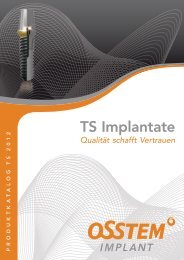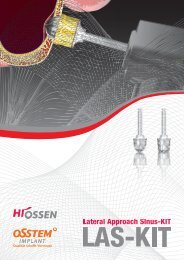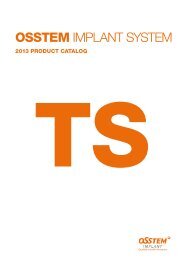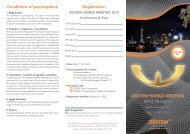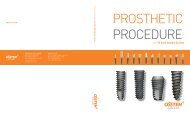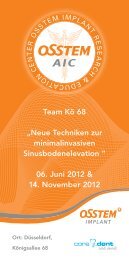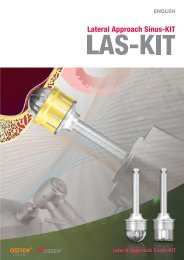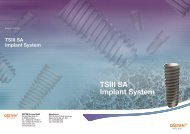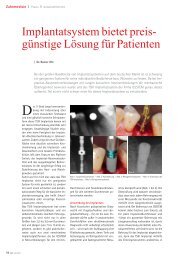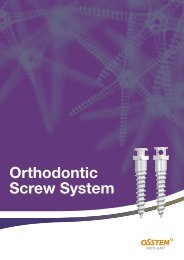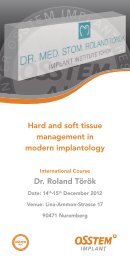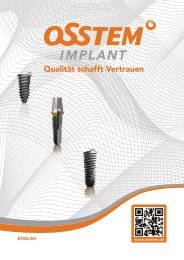Create successful ePaper yourself
Turn your PDF publications into a flip-book with our unique Google optimized e-Paper software.
Multicenter Retrospective Clinical Study of <strong>Osstem</strong> US IIImplant <strong>System</strong> in Complete Edentulous PatientsRetrospective Multicenter Cohort Study of the ClinicalPerformance of 2-stage Implants in South Korean PopulationsSu-Gwan Kim, Min-Suk Oh, Young-Kyun Kim, Hee-Kyun Oh, Gab-Lim Choi, Young-Hak OhJ Korean Implantology(KAOMI) 2007;11(3):12-21Seok-Min Ko, Jeong-Keun Lee, Steven E. Eckert, Yong-Geun ChoiInt J Oral & Maxillofac Implants 2006;21(5):785-8US <strong>System</strong> Clinical StudyIn this study, we analyzed data for edentulous patientsfrom multiple centers after installation of the <strong>Osstem</strong> US IIsystem in a retrospective study of patient gender, age,implant area, additional surgery, type of prosthesis, and theimplant survival and success rates. We then analyzed thesuccess rate after prosthetic restoration using implants incompletely edentulous patients to validate the usefulnessof the US II system.Between 1997 and 2005, of the patients who visited regionaldental clinics and private clinics nationwide (Department ofOral and Maxillofacial Surgery, Chosun University DentalCollege; Department of Oral and Maxillofacial Surgery anddental clinics, Seoul National University Bundang Hospital;Department of Oral and Maxillofacial Surgery, ChonnamUniversity Dental School; dental clinics, Daedong Hospital; AllDental Private Office) and underwent the <strong>Osstem</strong> US IIsystem implant procedure, our multicenter retrospectivestudy examined 44 completely edentulous patients (meanage 63.3 years) who received 276 implants. The followingresults were obtained.1. Eight of the 44 patients had systemic diseases, including 3patients with diabetes, 2 patients with cardiovasculardisease, and 1 patient each with cerebral infarction,hypertension, bronchial asthma, and Parkinson’s disease.2. The oral hygiene of the 44 patients was classified as goodin 36 patients, somewhat poor in 7 patients, moderatelypoor in 1 patient, and very poor in 0 patients.3. Of the implants installed, 80 were 20 mm long, 65 were11.5 mm long, 64 were 13 mm long, and 37 were 15mmlong; 175, 52, and 23 implants had diameters of 4.0,3.75, and 3.3 mm, respectively..4. When opposing teeth were encountered, 60 werenatural teeth, 13 were porcelain, 40 had gold crowns, 7were resin teeth, 90 were total dentures, and 66 wereimplant-repaired opposing teeth.6. The mean calculus index for the soft tissues near theimplants in 215 cases was 0.11, and the guminflammation index assessed in 226 cases averaged0.34. The plaque index measured in 225 cases averaged0.55, and the width of the attached gingiva measured in222 cases averaged 2.05 mm.7. For implant surgery, no additional surgery was performedin 161 cases (58.3%); maxillary sinus elevation via a lateralwindow was performed in 45 cases (16.3%); guided boneregeneration (GBR) was performed in 42 cases (15.2%);simultaneous maxillary sinus elevation and GBR wereperformed in 6 cases (2.1%); and veneer grafting wasperformed in 10 cases (3.6%).8. According to the implant method, two implants installedwith sinus lifting via a lateral window failed, for a survivalrate of 95.55% (43/45). Temporary complicationsdeveloped with the other procedures, but were resolvedin all cases, giving good results.9. Of the 276 implants installed, two failed and wereremoved for a final survival rate of 99.27%.Table 1. Distribution of implants by bone resorptionAmount of bone resorption (mm)No. of implantsNone 1810~0.9 61.0~2.0 35>2.0 9Table 2. Survival rate on total implantImplant statueNo. of implantsSurvival count 274Fail count 2Total 276Survival (percentage) 99.27%Purpose:To evaluate long-term follow-up clinical performance ofdental implants in use in South Korean populations.Materials and Methods:A retrospective multicenter cohort study design was usedto col-lect long-term follow-up clinical data from dentalrecords of 224 patients treated with 767 2-stageendosseous implants at Ajou University Medical Centerand Bundang Jesaeng Hospital in South Korea from June1996 through December 2003. Exposure variables such asgender, systemic disease, location, implant length, implantdiameter, prosthesis type, opposing occlusion type, anddate of implant placement were collected. Outcomevariables such as date of implant failure were measured.Table 1. Implant Failure and Survival by YearYearImplants at start ofintervalImplants lost tofollow-upResults:Patient ages ranged from 17 to 71.7 years old (mean age,45.6 years old). Implants were more frequently placed inmen than in women (61% versus 39%, or 471 men versus296 women). <strong>System</strong>ic disease was described by 9% ofthe patients. All implants had hydroxyapatite-blastedsurfaces. Most of the implants were 3.75 mm in diameter.Implant lengths 10 mm, 11.5 mm, 13 mm, and 15 mmwere used most often. Differences of implant survivalamong different implant locations were observed. Implantswere used to support fixed partial dentures for the majorityof the restorations. The opposing dentition was naturalteeth for about 50% of the implants. A survival rate of97.9% (751 of 767) was observed after 4.5 years (mean,1.95 ± 1.2 years).Conclusions:Clinical performance of 2-stage dental implantsdemonstrated a high level of predictability. The resultsachieved with a South Korean population did not differ fromresults achieved with diverse ethnic groups (Cohort Study).Failure % of total failure Cumulative failure1 767 754 13 81.3 98.32 754 752 2 12.5 98.03 752 751 1 6.2 97.94 751 751 0 0 97.94.5 751 751 0 0 97.9US <strong>System</strong> Clinical Study5. After implant installation, no bone resorption of thealveolar crest occurred in 181 cases, and more than 1mm of bone loss took place in 44 cases.5455



